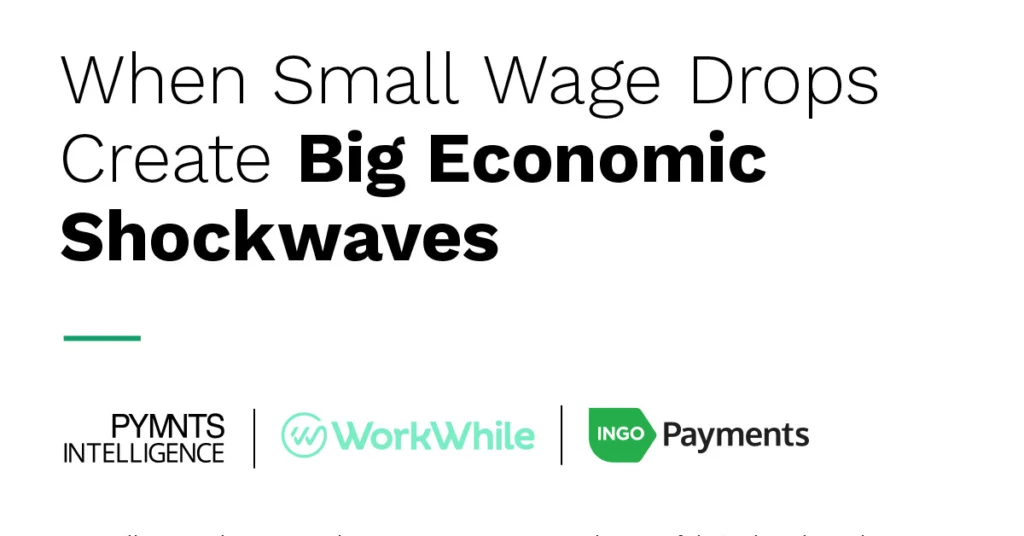By Drew Edwards, CEO, Ingo Money
I’ll be honest – this update hits home with me. After twenty-plus years powering money movement for banks and fintechs, so much of our business at Ingo is rooted in serving the Labor Economy: 60 million essential workers who serve the backbone of America: warehouse associates, servers, truck drivers, and more.
That’s why we’re thrilled to partner with PYMNTS Intelligence on the new Wage to Wallet Index.

The Data That Made Me Fix My Posture
Let me throw some numbers at you: 60 million Americans earn $25 an hour or less. They’re 36.5% of our workforce but they’re operating on financial margins that would make any CFO nervous; average liquid savings of $5,737 versus the typical American’s $9,869. And yet, there’s a punchline here: they drive $1.7 trillion (about $5,200 per person in the US) in annual consumer spending. That’s around 15% of everything we buy and sell in this country.
And I have a familial investment in this: I have family that lives this reality every day. Smart folks, working hard, and usually entrepreneurs. But their income is a patchwork of 1099s, project payments, and gig work that hits their account whenever it feels like it. Last month one of them was considering floating a car repair on his credit card because three different payments were “processing.” The irony isn’t lost on me – I run a company that moves money instantly, and my own family members are stuck waiting for checks to clear.
The Technical Reality Behind the Human Story
When we analyzed the disbursement data with PYMNTS, one stat jumped out above the rest: 55% of Labor Economy workers opt for instant pay when offered, even with a fee attached.
From a pure behavioral economics perspective, that’s completely rational. The NSF or overdraft fee from your bank is $35. A payday loan APR can hit 400%. The $1.50 to get your wages now? That’s just smart math, especially if you have bills coming due.
From a systems perspective, there’s other downstream effects to consider for this segment that are absolutely massive to everyone else: about 1% wage changes translates to $17 billion in GDP impact. The model shows recent fluctuations swinging from +$20 billion to -$40 billion in annualized consumer spending.
When you’re operating real-time payment infrastructure like we do, you see these patterns in transaction volumes before they show up in quarterly reports. Our original use case for “instant good funds for a fee” is still our largest use case: digitally cashing checks on mobile devices for consumers and SMBs. Interestingly, just prior to every recession we’ve lived through in recent memory, the demand for this service from this segment of consumers spikes up. As of writing this, the spike started in March and hasn’t slowed since. A recession appears to be looming from our data, and the reality is it always starts with the Labor Economy.
What This Means for Different Players
We’ll be regularly updating this index with PYMNTS going forward, giving everyone from community banks to Capitol Hill real-time visibility into this economy. Here’s how I see different groups using it:
Banks and Credit Unions: Track local economic health beyond FICO scores. If wage access speeds are declining in your market, that’s an early warning on loan performance. When instant pay adoption rises, that’s reduced overdraft revenue but increased deposit stability.
Fintechs and Employers: Use the wage volatility data to price earned wage access products properly. The index shows clear correlations between pay timing and spending patterns – that’s product development gold.
Policymakers: Finally, real data on how minimum wage changes, gig economy regulations, and safety net programs actually impact spending power. No more guessing whether that policy helped or hurt.
Moving Forward
Growing up in Georgia and being on the front lines of the banking industry for basically my entire life, I learned that the best businesses solve real problems for real people. This index gives us the instruments to track whether we’re really moving the needle on financial resilience for 60 million Americans who keep our economy running.
At Ingo, we’ve always believed that waiting for your own money is an antiquated concept. Now we have the data to prove why it matters at scale. We’re not just talking about individual financial wellness anymore. We’re talking about the velocity of money through entire communities.
That’s why this work is so important to us. When these workers thrive, we all do better.
